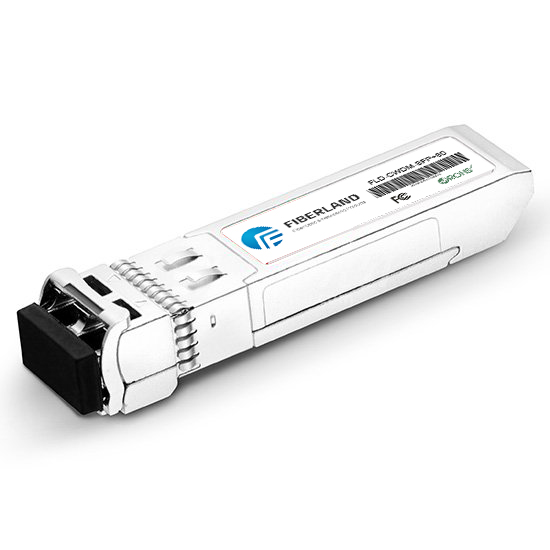What is Compact SFP (CSFP) fiber transceiver?
2017-06-15
The CSFP MSA defines a transceiver mechanical form-factor with latching mechanism and a host board, SFP-like, electrical edge connector and cage. The CSFF MSA also defines a transceiver mechanical form-factor. The Dual-Channel CSFP has the same mechanical dimensions as the industry standard SFP transceiver and is compatible with the standard SFP cage. The Single-Channel CSFP and CSFF are half the size of the industry standard SFP and SFF packages. The CSFF design is modular to enable configurations of integrated 1, 2 or 4 channel modules.These highly integrated compact transceiver modules will enable network system vendors to increase port density and data throughput, while reducing network equipment cost.CSFP transceivers are compatible with the Compact Small Form- Factor Pluggable (CSFP) Multi-Source Agreement (MSA).

Compact-SFP is a new kind of fiber transceiver usually known as CSFP fiber optic transceivers.CSFP has the same size of SFP, Cisco also called this as 2- channel bi-directional SFP. The 2-channel 1000BASE-BX-D SFP module, also known as Compact BIDI SFP, integrates two Bi-directional interfaces in one SFP module. The Compact SFP is always connected to two 1000BASE-BX10-U interfaces over two single strands of standard SMF with an operating transmission range up to 20km.
The CSFP transceiver consists of 2-channel Bi-directional transceiver unit with five sections: the LD driver, the limiting amplifier, the digital diagnostic monitor, the 1310nm DFB laser and the 1490nm PIN photo-detector. The optical output can be disabled by a TTL logic high-level input of Tx Disable, and the system also can disable the module via I2C. Tx Fault is provided to indicate that degradation of the laser. Loss of signal (LOS) output is provided to indicate the loss of an input optical signal of receiver or the link status with partner. The system can also get the LOS (or Link)/Disable/Fault information via I2C register access. Conventional SFP will function when plugged into a C-SFP socket, at the same time no damage to C-SFP and host board if C-SFP module is plugged into a conventional SFP socket. If you have interests about this CSFP transceiver, please feel free to send email to us.
SFP+ module,SFP+ transceiver,bidi sfp,XFP module,XFP transceiver Which is good? First choice FIBERLAND!Thanks for your concern, to learn more about FIBERLAND, please enter FIBERLAND website: http://www.fiberlandtec.com/

Compact-SFP is a new kind of fiber transceiver usually known as CSFP fiber optic transceivers.CSFP has the same size of SFP, Cisco also called this as 2- channel bi-directional SFP. The 2-channel 1000BASE-BX-D SFP module, also known as Compact BIDI SFP, integrates two Bi-directional interfaces in one SFP module. The Compact SFP is always connected to two 1000BASE-BX10-U interfaces over two single strands of standard SMF with an operating transmission range up to 20km.
The CSFP transceiver consists of 2-channel Bi-directional transceiver unit with five sections: the LD driver, the limiting amplifier, the digital diagnostic monitor, the 1310nm DFB laser and the 1490nm PIN photo-detector. The optical output can be disabled by a TTL logic high-level input of Tx Disable, and the system also can disable the module via I2C. Tx Fault is provided to indicate that degradation of the laser. Loss of signal (LOS) output is provided to indicate the loss of an input optical signal of receiver or the link status with partner. The system can also get the LOS (or Link)/Disable/Fault information via I2C register access. Conventional SFP will function when plugged into a C-SFP socket, at the same time no damage to C-SFP and host board if C-SFP module is plugged into a conventional SFP socket. If you have interests about this CSFP transceiver, please feel free to send email to us.
SFP+ module,SFP+ transceiver,bidi sfp,XFP module,XFP transceiver Which is good? First choice FIBERLAND!Thanks for your concern, to learn more about FIBERLAND, please enter FIBERLAND website: http://www.fiberlandtec.com/
RECENT BLOG POST
-
012019-10With the continuous development of 5G communication technology, 100G modules are gradually becoming popular. We know that there are many kinds of packages for 100G optical modules. From 2000 to now, the optical module package types have been rapidly developed. Its main package types are: GBIC, SFP, XENPAK, SNAP12, X2, XFP, SFP+, QSFP/QSFP+, CFP, CXP. In the fast-developing network era, some 100G optical modules avoid the risk of being eliminated, and upgraded and revised with the wave of the Internet, such as 100G CFP optical modules.
-
012019-101. What is the CWDM SFP? The CWDM optical module is an optical module using CWDM technology to implement the connection between the existing network device and the CWDM multiplexer/demultiplexer. When used with a CWDM multiplexer/demultiplexer, CWDM optical modules can increase network capacity by transmitting multiple data channels with separate optical wavelengths (1270 nm to 1610 nm) on the same single fiber.
-
012019-10AOC is the abbreviation of Active Optical Cables, which is called Active Optical Cables in Chinese. AOC active optical is to encapsulate two optical modules and cable together. Because the medium of transmission in the middle is optical cable, AOC optical module, which contains laser devices, has a higher price for DAC. However, its optical aperture is not exposed, it has high reliability, and its working distance can be customized for a long distance of less than 100 meters.
-
012019-10Dense Wavelength Division Multiplexing (DWDM) technology is capable of transmitting data in an optical fiber using bit wavelength parallel transmission or string line transmission using the wavelength of the laser.It is widely used in different fields of communication networks, including long-distance backbone networks, metropolitan area networks (MANs), residential access networks, and local area networks (LANs).The DWDM optical module is the optical module that uses this technology, so the DWDM optical module has high bandwidth and long-distance transmission characteristics.












